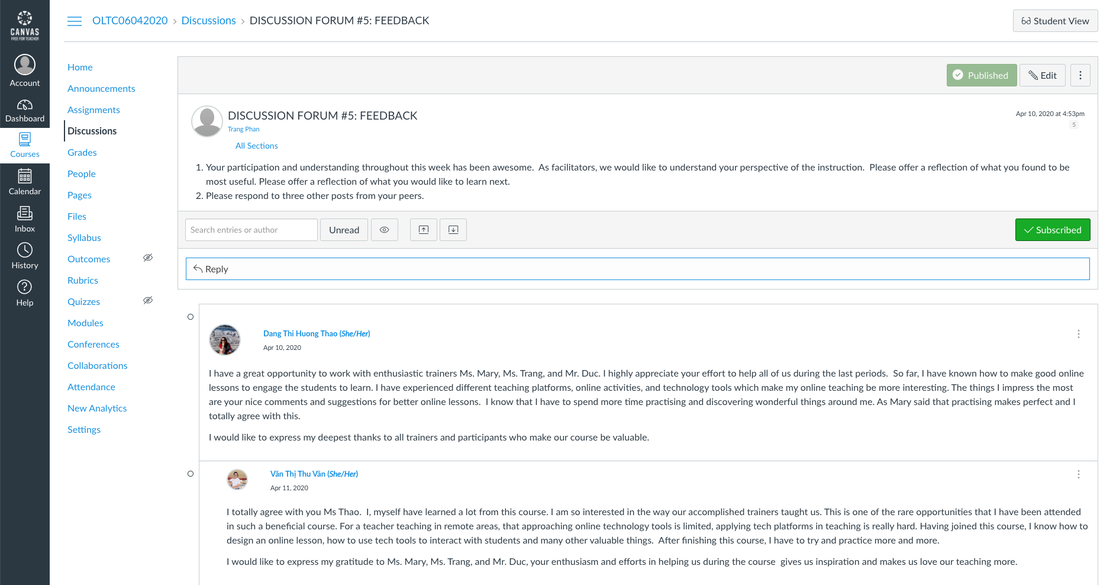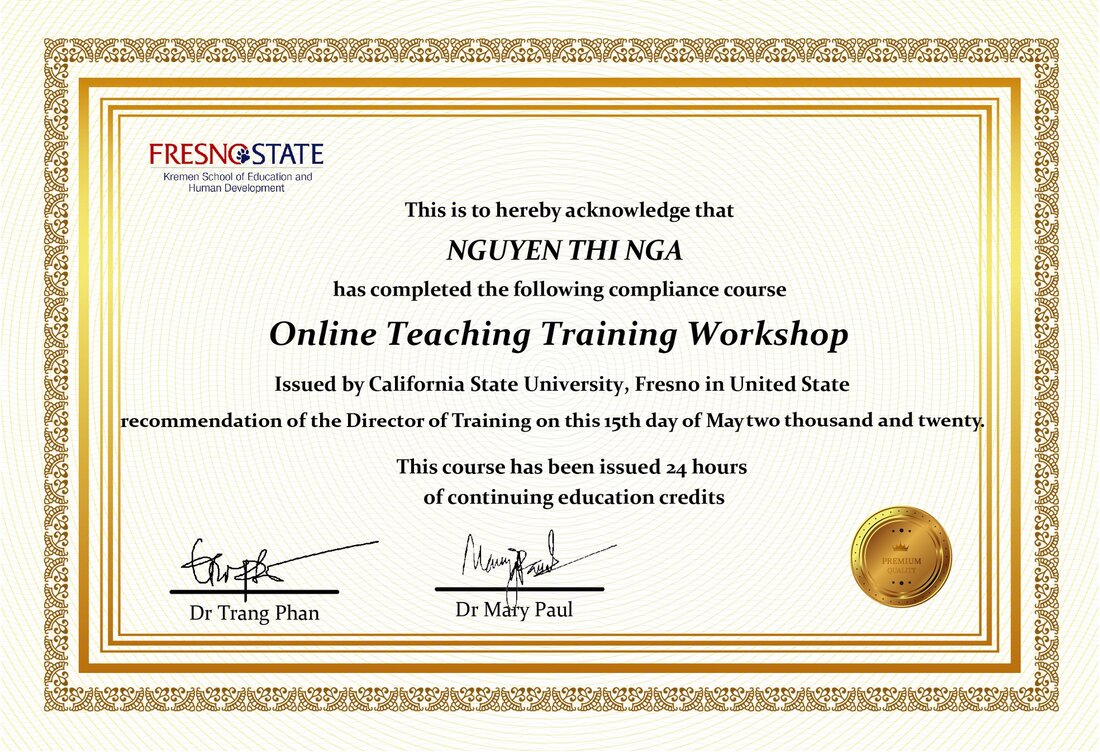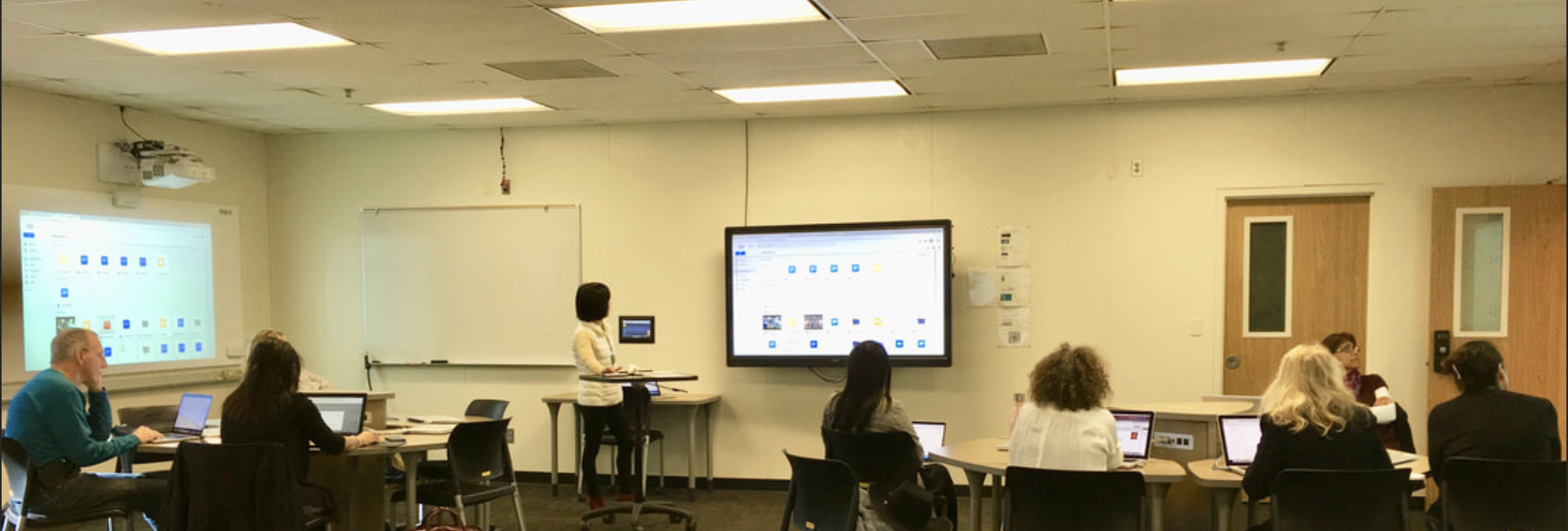Core Competencies
|
Research leadership + management: both x-functional teams & universities
Course design, assessment & research Publication & presentation Workshop design & delivery |
Application of design thinking & human-centered design in course work & research
Needs analysis research Quantitative, qualitative & mix-methods research Concept Mapping |
Project 1 | International Design and Instruction
Overview
Vietnam took a preventive approach to shut down schools and universities starting in February 2020 before the pandemic outbreak. This caused students to fall behind. In late March, 2020, my colleague and I were asked by the Vietnam National Academy of Education Management (NAEM) to urgently provide a virtual teaching course to the Vietnamese teachers to prepare them for effective virtual instruction.
Vietnam took a preventive approach to shut down schools and universities starting in February 2020 before the pandemic outbreak. This caused students to fall behind. In late March, 2020, my colleague and I were asked by the Vietnam National Academy of Education Management (NAEM) to urgently provide a virtual teaching course to the Vietnamese teachers to prepare them for effective virtual instruction.
My Role
I was the project lead and course designer. I was also a co-instructor alongside a colleague from Fresno State and the NAEM staff who invited us.
I was the project lead and course designer. I was also a co-instructor alongside a colleague from Fresno State and the NAEM staff who invited us.
Outcome
14 candidates received a Certificate of Completion from Fresno State after a 1-week training. End-to-end from course design to teacher certification was 2 weeks.
14 candidates received a Certificate of Completion from Fresno State after a 1-week training. End-to-end from course design to teacher certification was 2 weeks.
The Process
Needs Analysis
Key Findings
Needs Analysis
- Secondary research on status of online teaching and learning in Vietnam
- Interview with prospective students
Key Findings
- Vietnam was new to distance learning. It also had limited infrastructure and access to quality resources.
- The Vietnamese education system focused less on critical thinking and risk taking.
- Young Vietnamese were eager to learn English, but did not possess the highest English proficiency skills.
- The core audience would be K-12 teachers and college professors of various subjects (i.e. English, Chemistry, Medicine, Math, etc.).
- Their English proficiency level was intermediate-to-advanced.
- A significant number of the participants were technologically challenged.
Design Process
Key Considerations:
Training goals
Exit Performance
Key Considerations:
- How might we fit the experimental aspects of Western pedagogy into a low risk-taking Asian school culture?
- How might we build trust and pull the best from the students?
- How might we successfully navigate through the language barriers during instruction?
- How do we ensure day-to-day we're meeting the students' needs?
- Time constraints: the trainers had 1 week to prepare the instruction
- 14-hour time zone difference: between the trainers and trainees
- Language barriers: when new concepts were introduced and the conversation got complex
Training goals
- Students will be able to demonstrate using technological tools in teaching
- Students will participate in hands-on design and delivery of online lessons
- “Less is more”: avoid information avalanche
- Student-centered: make the assignments strictly relevant to their classroom environment in Vietnam
- Course sections should be project-based
- Technological tool demonstration + pedagogical discussion
- Hands-on, step-by-step technological "how-to" sessions
- Micro-teaching activities performed by the students
- 3-hour synchronous daily
- Personal tech assistance offline
- Daily reflection prompts and allowed responses in English and Vietnamese
- Daily Recap in English and Vietnamese
Exit Performance
- Students must design and teach a 45-minute lesson to the other trainees utilizing the tools and techniques learned in the course.
- The next day the students must teach their same lesson to their students. They must then record and report their student feedback on that lesson.
Project 2 | Enhancing Student-centered Learning with Technology
Overview
Part of my job is to provide technology training to faculty at the school of Education. This research project aims to give insights into faculty needs for technology training and designing a training program that meets those needs.
Part of my job is to provide technology training to faculty at the school of Education. This research project aims to give insights into faculty needs for technology training and designing a training program that meets those needs.
My Roles
As a solo project lead, my job involved:
Outcomes
As a solo project lead, my job involved:
- Conducting needs analysis research on faculty uses of technology for instructional purposes
- Designing a technological training program based on the needs analysis
- Collecting feedback on the user experience and revising the training program.
Outcomes
- Faculty could navigate the tool and use it for their course.
- Attending faculty submitted exit tickets about what they learned and in which areas they wished to learned more.
The Process
Needs Analysis
Key Findings
Needs Analysis
- Survey research: 47 faculty members on
- their personal and professional uses of technology
- their pedagogical beliefs
- their motivation and challenges in using technology in the classroom
- areas of training needed.
- Focus group interviews: 9 selected faculty participants (3 groups) that dived deeply into key survey questions.
Key Findings
- Most faculty used various technological tools for personal and professional purposes
- Some faculty were more open than others on trying new tools
- Their pedagogical beliefs dictated their uses of technology in the classroom
- Areas of training that faculty needed: student engagement tools, Google Classroom, and video production and editing
Design Process
Training goal
Exit performance:
Faculty can navigate the tool and use it in some designated teaching activities.
Training goal
- Helping faculty acquire technological skills in the indicated areas
- Small groups
- Close-up discussion
- Technological tool demonstration + pedagogical discussion
- Hands-on technological how-to sessions
- Micro-demo activities by the faculty
- 2-hour synchronous per workshop
- Some faculty could not join due to schedule conflicts
- Faculty expressed needing more than 2 hours for each tool or application.
Exit performance:
Faculty can navigate the tool and use it in some designated teaching activities.
Project 3 | Learning Space Innovation
Overview
As Director of the Learning Resource Center (INTERESC), I was asked by the college Dean to renovate the current learning center to provide learning space with resources for 1,000+ students. The funds was provided by CalState TEACH ($88k).
As Director of the Learning Resource Center (INTERESC), I was asked by the college Dean to renovate the current learning center to provide learning space with resources for 1,000+ students. The funds was provided by CalState TEACH ($88k).
My Role
Writing a proposal with project vision and budget to secure the funds.
As the project lead, I worked with a team including Vice-president/facilities manager, facilities planning, IT, special project coordinator, and procurement throughout the whole process. This involved demolishing old facility, budgeting, space design, choosing and ordering furniture, IT set up for individual and group work stations.
Outcomes
There were 903,023 visits to the center for 34 opening weeks compared to 780,128 the previous year for 52 weeks. That was almost 16% increase despite the shortage of 16 opening weeks.
Writing a proposal with project vision and budget to secure the funds.
As the project lead, I worked with a team including Vice-president/facilities manager, facilities planning, IT, special project coordinator, and procurement throughout the whole process. This involved demolishing old facility, budgeting, space design, choosing and ordering furniture, IT set up for individual and group work stations.
Outcomes
- Space design that met mobility and flexibility criteria for meetings and group work
- 3 high tables and chairs
- 4 double detachable tables and chairs, all on wheels
- 4 computer desks
- 2 group work station with IT facilities (i.e. monitors, projectors, connectivity ports)
- 12 Apple computers for student and faculty uses
- 3 high tables and chairs
- Tech support services that met students' and faculty's needs
- Printing services
- Tech support help desk
- Equipment checkout
- Classroom tech services
- Printing services
There were 903,023 visits to the center for 34 opening weeks compared to 780,128 the previous year for 52 weeks. That was almost 16% increase despite the shortage of 16 opening weeks.
The Process
Needs Analysis
Informal conversations/interview with students and faculty about how they envisioned using the space and what technology needed for individual and group work.
Key Findings
Needs Analysis
Informal conversations/interview with students and faculty about how they envisioned using the space and what technology needed for individual and group work.
Key Findings
- Students needed a place to study individually, do group work, or just take a short break between classes
- Students needed work stations with IT facilities
- Student needed basic technology support when they had questions
- Faculty needed a meet and greet place with students
- Faculty needed tech equipment checkout
Design Process
Time frame: 1 year
Goals:
Time frame: 1 year
Goals:
- Providing space for individual learning and group work
- Providing space for student-faculty meetings
- Providing technology support services for students and faculty
- Facilitating mobility and flexibility for meetings and group work
- Demolishing the old facility
- Budgeting
- Space design
- Choosing furniture: for mobility purposes, everything is on wheels
- IT set up for individual and group work stations.
- Schedule conflicts with the IT, facilities planning, and construction teams
- The demolishing and re-construction did not happen as fast since the construction teams were also working on different orders
- The center services had to cease for a few months when demolishing and re-construction happened.
|
Before
|
After
|






